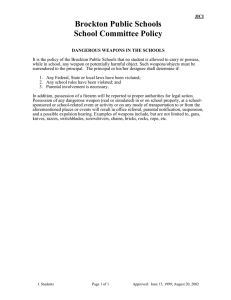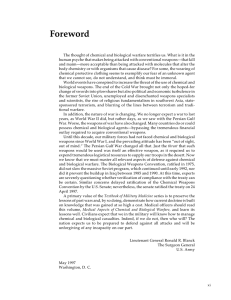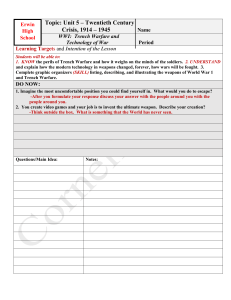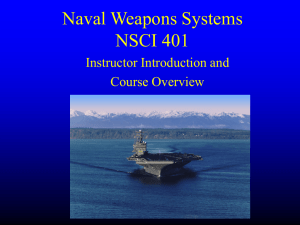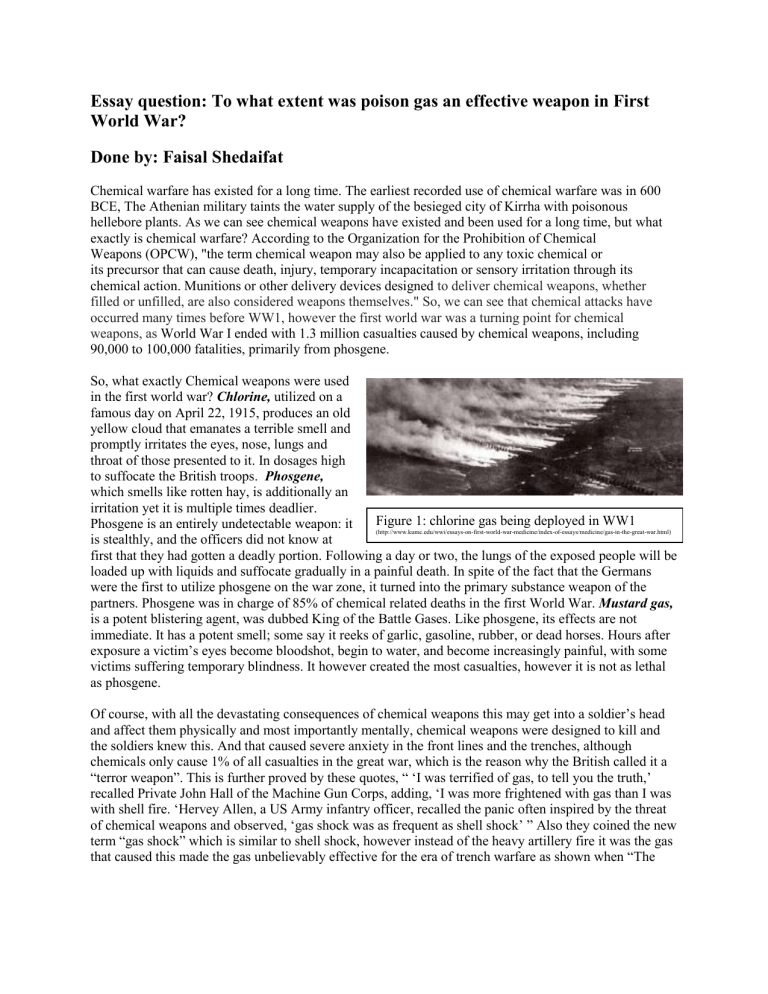
Essay question: To what extent was poison gas an effective weapon in First World War? Done by: Faisal Shedaifat Chemical warfare has existed for a long time. The earliest recorded use of chemical warfare was in 600 BCE, The Athenian military taints the water supply of the besieged city of Kirrha with poisonous hellebore plants. As we can see chemical weapons have existed and been used for a long time, but what exactly is chemical warfare? According to the Organization for the Prohibition of Chemical Weapons (OPCW), "the term chemical weapon may also be applied to any toxic chemical or its precursor that can cause death, injury, temporary incapacitation or sensory irritation through its chemical action. Munitions or other delivery devices designed to deliver chemical weapons, whether filled or unfilled, are also considered weapons themselves." So, we can see that chemical attacks have occurred many times before WW1, however the first world war was a turning point for chemical weapons, as World War I ended with 1.3 million casualties caused by chemical weapons, including 90,000 to 100,000 fatalities, primarily from phosgene. So, what exactly Chemical weapons were used in the first world war? Chlorine, utilized on a famous day on April 22, 1915, produces an old yellow cloud that emanates a terrible smell and promptly irritates the eyes, nose, lungs and throat of those presented to it. In dosages high to suffocate the British troops. Phosgene, which smells like rotten hay, is additionally an irritation yet it is multiple times deadlier. Figure 1: chlorine gas being deployed in WW1 Phosgene is an entirely undetectable weapon: it (http://www.kumc.edu/wwi/essays-on-first-world-war-medicine/index-of-essays/medicine/gas-in-the-great-war.html) is stealthly, and the officers did not know at first that they had gotten a deadly portion. Following a day or two, the lungs of the exposed people will be loaded up with liquids and suffocate gradually in a painful death. In spite of the fact that the Germans were the first to utilize phosgene on the war zone, it turned into the primary substance weapon of the partners. Phosgene was in charge of 85% of chemical related deaths in the first World War. Mustard gas, is a potent blistering agent, was dubbed King of the Battle Gases. Like phosgene, its effects are not immediate. It has a potent smell; some say it reeks of garlic, gasoline, rubber, or dead horses. Hours after exposure a victim’s eyes become bloodshot, begin to water, and become increasingly painful, with some victims suffering temporary blindness. It however created the most casualties, however it is not as lethal as phosgene. Of course, with all the devastating consequences of chemical weapons this may get into a soldier’s head and affect them physically and most importantly mentally, chemical weapons were designed to kill and the soldiers knew this. And that caused severe anxiety in the front lines and the trenches, although chemicals only cause 1% of all casualties in the great war, which is the reason why the British called it a “terror weapon”. This is further proved by these quotes, “ ‘I was terrified of gas, to tell you the truth,’ recalled Private John Hall of the Machine Gun Corps, adding, ‘I was more frightened with gas than I was with shell fire. ‘Hervey Allen, a US Army infantry officer, recalled the panic often inspired by the threat of chemical weapons and observed, ‘gas shock was as frequent as shell shock’ ” Also they coined the new term “gas shock” which is similar to shell shock, however instead of the heavy artillery fire it was the gas that caused this made the gas unbelievably effective for the era of trench warfare as shown when “The capacity of gas to inspire fear was apparent from its first large-scale use on the Western Front. At Langemarck, on 22 April 1915, the release of 150 tons of chlorine from 6,000 cylinders caused widespread panic. The chaotic retreat of two French divisions, 87th Territorial and 45th Algerian, opened a 4-mile gap in the front line. As these troops had no protective equipment or any training in gas warfare, it was scarcely surprising that they fled when confronted with a suffocating, greenish-yellow cloud. In September 1915, when the British released chlorine in retaliation, similar effects were observed of German troops at Loos: A German officer in this sector remarked that as soon as the gas entered his trench, he lost all control of his men, a panic ensued Figure 2: British troop running from the toxic and he was unable to keep them in the front line. He gas (university of Kansas medical center) said that, without the gas, we should have had no earthly chance of taking the trenches. “Uncontrolled anxiety during a gas attack could cause men to tear off their protective masks and lose all sense of reason this is the reason why gas attacks were so successful, they would scare soldiers to death and as previously mentioned when at Langemarck the Germans were able to get the French to retreat 4 miles away. It both effected soldiers mentally and physically and that’s why it was so good at defeating the enemy as they lost all train of thought and all logic and reason this eventually lead to the conclusion that if one is scared of the gas the more likely they are going to die if they are exposed to it, leading to mental health playing a massive part in the war whether they knew about it or not. In the great war, there was no Geneva convention yet, and as a result there were no international laws on what is allowed and what is not, although there was one piece treaty that banned poisoned bullets. This helped the Germans bring new and dangerous weapons without it being considered a war crime such as poison gas and flamethrowers, however they were considered by the public as “cheating” of some sort by outplaying the competition and developing more lethal weapons quicker and making Figure 2: British troop waiting in line for treatment for more. However, dying from poison gas gas related injuries (The conversation) would usually be very painful and would usually last for a few hours, and if he survived there is a chance that he would have severe brain damage or psychical damage. Of course, there is another point to be made to at the time there was a CWC convention (Chemical Weapons Convention) that banned weapons of this class, however theoretically it allows for enough poison gas to kill 1 billion people and in fact at the time more than 80 countries listed that they are conducting chemical weapon research. Till this day militaries still use chemical weapons; a well-known example would be in the Vietnam war when the US deployed Napalm. So personally, I believe that it was ethical to use poison gas as its lethality was much less than say heavy bombardment, also we mustn’t forget that it was an allout war and not many rules were set beforehand so from my point of view they tried to take advantage of that and develop the best weapon to use which at the time was poison gas. The development of chemical weapons allowed for other more destructive weapons to be produced in massive bulk, for example because Hitler did not want to use chemical weapons due to his experience with chemical weapons, especially in WW1 when he was gassed in the trenches and suffered as a result. This pushed him to attempt to create an alternative WMD which would ultimately be a nuclear weapon, but as we know America was able to develop it first in the Manhattan project, however WW1’s use of chemical warfare would not just alter modern politics related to this subject it defined it. The first example I would like to talk about would be the incident that occurred in Iraq 1988 were Saddam gassed Figure 3: An Iraqi Kurdish man visiting the and killed 4000 Kurds, this of course was one of the main graveyard of the victims of Saddam’s attack reasons why Britain invaded Iraq, and this was one of the only proofs of Saddam’s war crimes which ultimately lead to the death penalty; if it were not for what occurred in the great war it would not be as frowned upon as it is now. Another subject I would like to touch on would be in the Vietnam war was were Agent orange was used against village and cities to kill and decimate the nature around them. However, this had some unintended consequences such as the birth defects that occurred to the women that were exposed to the Agent and survived also they could get many sicknesses, one of them being cancer. Agent Orange was the most widely used herbicide in Vietnam, and the most potent. It was available in slightly different mixtures, sometimes referred to as Agent Orange I, Agent Orange II, Agent Orange III and “Super Orange.” More than 13 million gallons of Agent Orange was used in Vietnam, or almost twothirds of the total number of herbicides used during the entire Vietnam War. This of course heavily effected the eco-system of the areas that it was used in, killing everything that was inside it. However, the kids that had to suffer from this agent were both mentally and physically effected by this, and even more shockingly this was not considered a war crime while the Germans were convicted of war Figure 4: Young boy suffering the crimes for much less; this of course enraged many consequences of Agent orange Vietnamese as when they see their new generation suffering they can do nothing to the people that did this as they were not convicted guilty of any wrong doing. To conclude this essay, I would like to review what we talked about and add my personal opinion on this subject. To start off we talk about what chemical gases are, as we said chemical weapons are weapons that have chemical properties that are meant to harm/kill who come in contact with him. Then we talked about what weapons were used in the war that being chlorine gas, sulfur gas and phosgene in which we talked about their lethality. Then we talked about the effectiveness of the gas, which I personally believe was extremely effective as a form of propaganda as it instills fear in the soldier’s heart’s and it is also use a form of deterrent as if the ally’s army did something the German’s may have easily retaliated by gassing the cities which considerably made the war more controlled and predictable and kept civilian death to a minimum, it also made soldiers and the cities more aware to the dangers of chemical warfare by keeping gas masks. Because of that the Geneva convention occurred were they discussed the rules of war and put laws that ultimately was used to convict Nazi Germany of war crimes. We also talked about how this effected politics after the war, of course this made chemical warfare frowned upon and feared, this is why it is considered a weapon of mass destruction. This also pushed Hitler to look for another weapon of mass destruction which as we know is a nuclear bomb. Also, because chemical weapons are so frowned upon this pushed the British to invade Iraq when they discovered that Saddam Hussain gassed a Kurdish village; this was also used to convict him of war crimes which he was punished with for death. This also made the American’s use of Age nt Orange disliked by the public as it effected the battlefield for decades, infect till now children are being born with deformities because of it. Finally, I would like to point out that without the use of chemical weapons in WW1 the following wars would have been much more chaotic and that there would be no Geneva convention which would have got the Nazi’s be able not to be convicted for war crimes. A we can see chemical weapons is not entirely bad but beneficial for many different reasons which helped put laws on wars and war crimes. Citation page: Imperial War Museum Sound Archive, 14599, code A, reel 2, Private John Hall. Winter Denis. Death’s Men: Soldiers in the Great War. Harmondsworth: Penguin; 1979. p. 121. The National Archives, Kew, London (hereafter TNA), WO 142/100, C.G. Douglas, ‘Note of the Total Casualties Caused in the British Forces by Gas Warfare’, typescript, 17 January 1919, p. 30. Liddell Hart Basil. History of the First World War. London: Pan; 1972. pp. 183–4. [Google Scholar] Sturdy Steve. War as Experiment: Physiology, Innovation and Administration in Britain, 1914–1918 – The Case of Chemical Warfare. In: Cooter Roger, Harrison Mark, Sturdy Steve., editors. War, Medicine and Modernity. Stroud: Sutton; 1998. p. 65. [Google Scholar] Carter GB, Pearson Graham S. Past British Chemical Warfare Capabilities. RUSI Journal. 1996;CXLI:59–68. [Google Scholar] Edmonds James E. Military Operations, France and Belgium, 1915, History of the Great War. London: Macmillan; 1928. p. 179. [Google Scholar] TNA, WO 142/99, Waugh Captain AJ. Committee on Treatment of Gas Cases. 1916 May 18;:303.[Google Scholar] TNA, WO 142/105, Report by Captain Herbert Cook. 1918. Feb, Wilson Charles. The Anatomy of Courage. London: Collins; 1945. p. 187. [Lord Moran] [Google Scholar] berger, Mindy. “World War I Unleashed Chemical Weapons and Changed Modern Warfare.” LiveScience, Purch, 6 Apr. 2017, www.livescience.com/58569-chemical-weapons-world-warone.html. “A Brief History of Chemical War.” Science History Institute, 17 Apr. 2017, www.sciencehistory.org/distillations/magazine/a-brief-history-of-chemical-war. Jones, Edgar. “Terror Weapons: The British Experience of Gas and Its Treatment in the First World War.” War in History, U.S. National Library of Medicine, July 2014, www.ncbi.nlm.nih.gov/pmc/articles/PMC5131841/#R9. “When Saddam Hussein Gassed 5,000 Kurds at Halabja.” Daily Nation, 14 Mar. 2018, www.nation.co.ke/news/world/When-Saddam-Hussein-gassed-5000-Kurds-Halabja-Iraq/1068-43407581h04fq/index.html.

